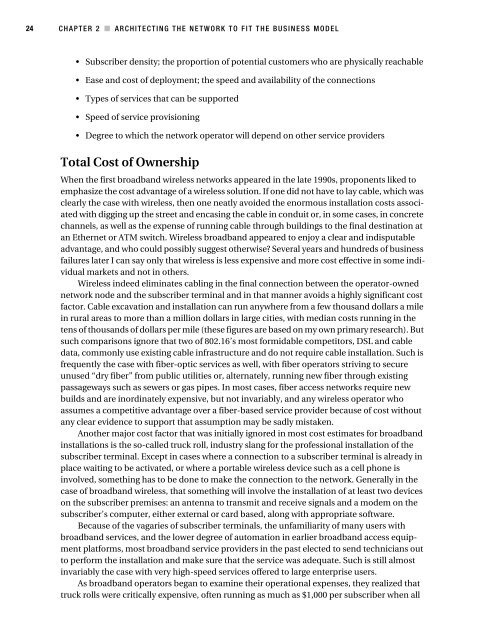WiMax Operator's Manual
WiMax Operator's Manual
WiMax Operator's Manual
Create successful ePaper yourself
Turn your PDF publications into a flip-book with our unique Google optimized e-Paper software.
24 CHAPTER 2 ■ ARCHITECTING THE NETWORK TO FIT THE BUSINESS MODEL<br />
Subscriber density; the proportion of potential customers who are physically reachable<br />
Ease and cost of deployment; the speed and availability of the connections<br />
Types of services that can be supported<br />
Speed of service provisioning<br />
Degree to which the network operator will depend on other service providers<br />
Total Cost of Ownership<br />
When the first broadband wireless networks appeared in the late 1990s, proponents liked to<br />
emphasize the cost advantage of a wireless solution. If one did not have to lay cable, which was<br />
clearly the case with wireless, then one neatly avoided the enormous installation costs associated<br />
with digging up the street and encasing the cable in conduit or, in some cases, in concrete<br />
channels, as well as the expense of running cable through buildings to the final destination at<br />
an Ethernet or ATM switch. Wireless broadband appeared to enjoy a clear and indisputable<br />
advantage, and who could possibly suggest otherwise? Several years and hundreds of business<br />
failures later I can say only that wireless is less expensive and more cost effective in some individual<br />
markets and not in others.<br />
Wireless indeed eliminates cabling in the final connection between the operator-owned<br />
network node and the subscriber terminal and in that manner avoids a highly significant cost<br />
factor. Cable excavation and installation can run anywhere from a few thousand dollars a mile<br />
in rural areas to more than a million dollars in large cities, with median costs running in the<br />
tens of thousands of dollars per mile (these figures are based on my own primary research). But<br />
such comparisons ignore that two of 802.16’s most formidable competitors, DSL and cable<br />
data, commonly use existing cable infrastructure and do not require cable installation. Such is<br />
frequently the case with fiber-optic services as well, with fiber operators striving to secure<br />
unused “dry fiber” from public utilities or, alternately, running new fiber through existing<br />
passageways such as sewers or gas pipes. In most cases, fiber access networks require new<br />
builds and are inordinately expensive, but not invariably, and any wireless operator who<br />
assumes a competitive advantage over a fiber-based service provider because of cost without<br />
any clear evidence to support that assumption may be sadly mistaken.<br />
Another major cost factor that was initially ignored in most cost estimates for broadband<br />
installations is the so-called truck roll, industry slang for the professional installation of the<br />
subscriber terminal. Except in cases where a connection to a subscriber terminal is already in<br />
place waiting to be activated, or where a portable wireless device such as a cell phone is<br />
involved, something has to be done to make the connection to the network. Generally in the<br />
case of broadband wireless, that something will involve the installation of at least two devices<br />
on the subscriber premises: an antenna to transmit and receive signals and a modem on the<br />
subscriber’s computer, either external or card based, along with appropriate software.<br />
Because of the vagaries of subscriber terminals, the unfamiliarity of many users with<br />
broadband services, and the lower degree of automation in earlier broadband access equipment<br />
platforms, most broadband service providers in the past elected to send technicians out<br />
to perform the installation and make sure that the service was adequate. Such is still almost<br />
invariably the case with very high-speed services offered to large enterprise users.<br />
As broadband operators began to examine their operational expenses, they realized that<br />
truck rolls were critically expensive, often running as much as $1,000 per subscriber when all
















